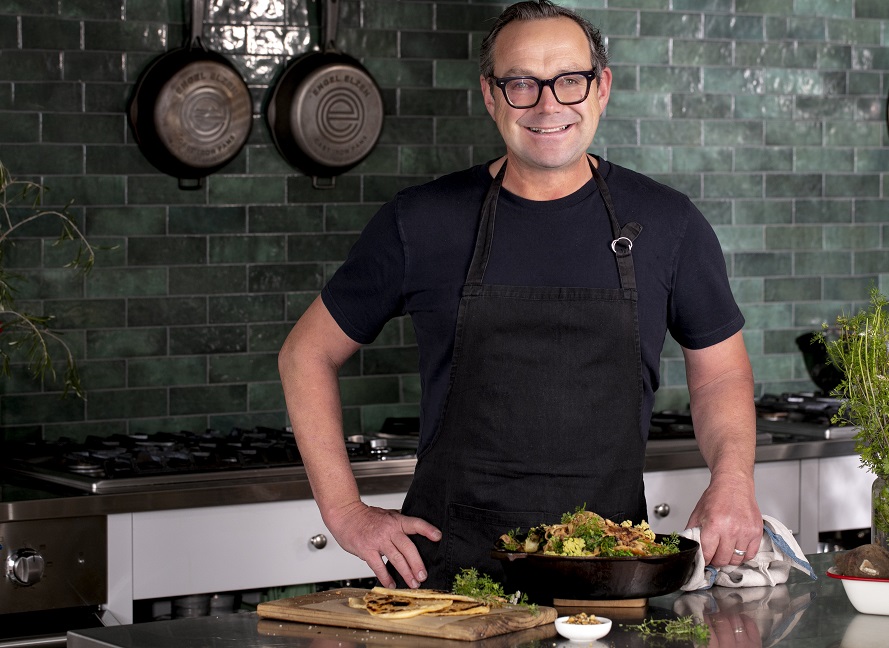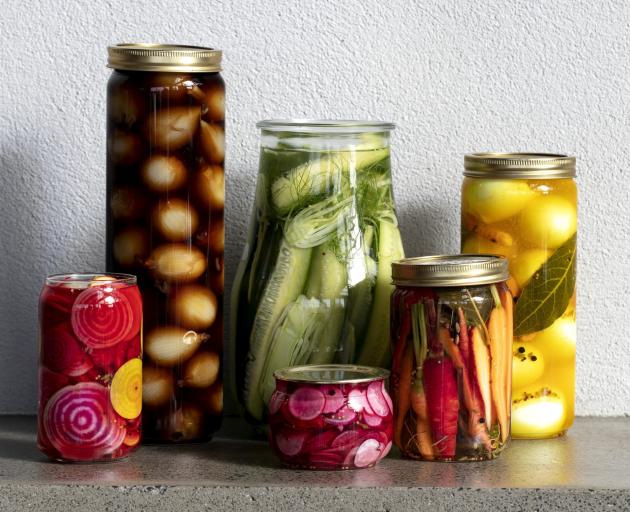
"It is a philosophy that food truly does taste better when it’s made from scratch with quality produce, when you know where your raw ingredients have come from and, in turn, what is going into your body."
He is hoping his new book will encourage others on their own good from scratch journey. His own began on a poultry farm in West Auckland where he grew up watching his mother cook, bake and preserve — and make curried eggs for every gathering.
Van de Elzen started out washing dishes in a restaurant at the age of 14, following in the footsteps of his sisters who waitressed there.
"I loved the energy, the banter and the camaraderie - I was hooked."
After finishing school he continued to work in kitchens, working his way up the ladder and then moved to London to learn more. He met Bee and worked at Bluebird, a Terence Conran (of Habitat fame) restaurant and a large 1000-set fine dining restaurant, Bank.

"This was where the seed of the dream for our own cookery school was planted. For me as a chef it seemed like the ultimate journey, to take a seed and see it all the way through to beautiful plates of food."
They returned to New Zealand in 2003 and went on to own various restaurants such as Molten, The Food Truck and Boy and Bird, but once they had their two daughters they wanted a slower pace of life, more of a work-life balance.
Van de Elzen began working in television at this time and realised a lot of people struggled with making healthy choices or home-cooked meals from scratch.
"This furthered my mission to show Kiwis how to cook quality, delicious food that didn’t have to be complicated or break the bank."
In 2015, they bought a small 15-acre farm in Muriwai, northwest of Auckland, and started planting trees, an orchard and garden.
They opened the Good from Scratch Cookery School in 2020, making a dream come true.
"To be able to share with people the benefits of cooking ‘paddock to plate’."
The book is a collection of recipes that have developed, tweaked and recreated in the school, guided by the seasons and inspired by their philosophy.
"Feel free to put your own twist on things based on what is in season or in your fridge."

Perfect roast chicken with pickled fennel,
halloumi and mint emulsion
Prep time: 45 minutes
plus brining and pickling time
Cook time: 45 minutes
plus resting time
Serves 6 to 8
INGREDIENTS
10 baby fennel bulbs
½ recipe basic pickling brine
200g halloumi
1 Tbsp grapeseed oil
¼ cup plain flour
1 cup black quinoa
1 Granny Smith apple
1 recipe mint emulsion (see below)
Flaky sea salt, to taste
10 fresh mint leaves
¼ cup almonds
Borage flowers for garnish (optional)
PERFECT ROAST CHICKEN
2 litres water
200g flaky sea salt
1 lemon, crushed
2 bay leaves
10 peppercorns
1 size 14 chicken
1 Tbsp Dijon mustard
To cook the perfect roast chicken, first clear some room in your fridge to fit a large pot or container. Make up the brine by combining quarter of the water and the salt in a large pot and gently heating until the salt is dissolved (it doesn’t need to boil). Add the remaining water and the lemon, bay leaves and peppercorns. Pop the chicken in the pot, ensuring it’s covered in the brine. Chill for 12 hours.
Remove the chicken and rinse off the excess brine. Place in a roasting dish, pat dry and brush with the mustard.
Preheat your oven or wood-fired oven to 180°C fan-bake. Place the chicken in the centre of the oven and roast for about 40 minutes, or until the internal temperature of the thickest part of the breast reaches 75°C. Allow to rest for at least 10 minutes before shredding.
While the chicken is roasting, place the fennel in a bowl. Bring the basic pickling brine to the boil. Pour the brine over the fennel, allow to sit for at least 30 minutes to pickle, then drain well.
Cut the halloumi into 1cm slices. Heat the oil in a frypan over a medium heat. Run the halloumi through the flour and then gently drop it into the frypan. Cook until golden brown before turning and cooking the other side. Remove from the pan and set aside.
Cook the quinoa according to the packet instructions.
Core the apple, slice it finely and place it in a bowl with the quinoa and half the shredded chicken. Add 3 tablespoons of the mint emulsion and season with salt. Mix well and spread out on a platter. Sprinkle the drained fennel, the mint and the remaining chicken over the top. Top with the fried halloumi, almonds, a little more mint emulsion and borage flowers (if using). Serve the remaining mint emulsion on the side.
Mint emulsion
Makes 2 cups
INGREDIENTS
2 eggs
¼ cup orange juice
¼ cup lemon juice
1 Tbsp miso paste
1 Tbsp brown sugar
1 Tbsp chopped fresh ginger
1 clove garlic, peeled
10 fresh mint leaves
300ml grapeseed oil
Fine sea salt, to taste
Method
Bring a small pot of water to the boil and carefully drop in the eggs. Boil for 5 minutes, then immediately transfer the eggs to a bowl of iced water to halt the cooking. Carefully roll the eggs to break the shells before peeling.
Place the eggs in a blender with all the remaining ingredients except the oil and salt and blend slowly first before turning up to a higher speed. Once smooth, drizzle in the oil with the blender going.
Make sure to add the oil slowly to ensure the emulsion doesn’t split. If the emulsion becomes too thick to blend, add a little water. Taste and adjust the salt.
Store the emulsion in the fridge for up to 4 days.

Basic pickling brine
Prep time 10 minutes
Cook time 5 minutes
Makes 1.25 litres
INGREDIENTS
700ml water
500ml cider vinegar
1 cup sugar
5 cloves garlic, peeled
4 bay leaves
1 Tbsp peppercorns
1 Tbsp coriander seeds, toasted
1 Tbsp fennel seeds, toasted
1 Tbsp mustard seeds, toasted
½ Tbsp fine sea salt
Combine all the ingredients in a pot and bring to the boil, stirring, until the sugar and salt have dissolved. Allow to cool, then store in the fridge for up to a month until required. It can be used hot or cold. For cold pickles just add your prepared vegetables. For a hot pickle, boil the brine first.
Use the brine cold for pretty much any vegetable that you want to have a raw crunch. Just prepare the vegetable then submerge it in the brine for at least an hour. Pickles will keep in the fridge for up to 1 month.

Son-in-law eggs with sticky pork
& Nam Jim dressing
Our kids just love this! It’s more of a meal than a salad and the kids can happily demolish a couple of servings each. The pork is slowly cooked over a period of hours in an Asian broth, which is reduced down afterwards to caramelise the pork. Son-in-law eggs are something else again, with a hot yolk on the inside and crispy deliciousness on the outside. There’s a little bit of work involved in making this dish, so wait until the weekend if making it for the first time.
Prep time 40 minutes plus marinating time
Cook time 3 hours 15 minutes
Serves 6-8
INGREDIENTS
500g piece pork belly
1 whole bulb garlic
1 thumb-sized knob fresh ginger, grated
6 Tbsp soy sauce
6 Tbsp hoisin sauce
6 Tbsp black or malt vinegar
2 Tbsp brown sugar
10 star anise
6 eggs
1 Tbsp grapeseed oil
200ml canola oil for frying
1 cucumber, sliced
4 spring onions, sliced
3 cups bean sprouts
2 green chillies, finely sliced
1 recipe Nam Jim Dressing
1 cup fresh coriander leaves
½ cup roasted peanuts, crushed
3 limes
Method
Place the pork belly on a double layer of tinfoil.
Break the garlic bulb into cloves, smash each clove with the flat of a knife to loosen the skin, then remove and discard the skins. Place the peeled garlic in a bowl with the ginger, soy sauce, hoisin sauce, vinegar, sugar and star anise and combine well. Pour over the pork and rub all over. Cover the pork with a sheet of baking paper and then another layer of tinfoil. Seal up as well as you can and place in the fridge for a couple of hours to marinate.
Preheat your oven to 160°C fan-bake. Place the pork parcel in a roasting dish and roast for 2 hours. Check the pork and remove the top layer of tinfoil and paper. Place back in the oven for 1 hour.
Bring a medium pot of water to the boil and carefully drop in the eggs. Boil for 5 minutes, then immediately transfer the eggs to a bowl of iced water to halt the cooking. Carefully roll the eggs to break the shells before peeling.
Remove the pork from the cooking juices and slice into thick slices. Heat a heavy-based frypan, add the grapeseed oil and fry the pork slices on both sides. Carefully pour in the leftover braising liquid and simmer until reduced and syrupy.
Place the canola oil in a small pot and heat to 180°C (350°C). Use a probe thermometer to measure. Carefully drop in the eggs in two batches and fry until golden brown.
Combine the cucumber, spring onions, bean sprouts and chillies in a bowl. Dress with half the Nam Jim Dressingand top with the pork strips, eggs, coriander and crushed peanuts. Serve with lime wedges and the remaining Nam Jim Dressingon the side.
Nam Jim Dressing
Makes ½ a cup
2 cloves garlic peeled
3 coriander roots, cleaned
3 green chillies
150ml lime juice
3 Tbsp fish sauce
3 Tbsp brown sugar
Using a pestle and mortar, pound the garlic and coriander roots to a paste.
Add the chillies then the lime juice and continue to pound. Add the fish sauce and brown sugar.
Taste and adjust quantities if necessary - you’re looking for a balance of flavour, not too salty, sweet or sour.

Rhubarb tart
Prep time
40 minutes plus chilling time
Cook time
50 minutes
Serves 6
INGREDIENTS
1 recipe Sweet Shortcrust (see below)
4 stalks of rhubarb
½ cup caster sugar
½ cup water
Juice of 1 lemon
1 vanilla bean, split
100g unsalted butter
½ cup caster sugar
1 egg
1 egg yolk
1 cup ground almonds
¼ cup plain flour
Sweet shortcrust
225g plain flour
⅓ cup caster sugar
125g unsalted butter, cubed and chilled
1 egg yolk
1 Tbsp chilled water
To make the Sweet Shortcrust, combine the flour and sugar in a large bowl. Add the butter and rub it between your fingers until the mixture resembles fine breadcrumbs.
Add the egg yolk and water and mix until a dough starts to form. Add more water if required. Turn out on to a lightly floured bench and knead until just smooth. Wrap in baking paper and chill for 30 minutes.
Preheat your oven to 180°C fan-bake.
Roll out the pastry on a lightly floured surface until it is 3mm thick. Wrap it loosely back on to your rolling pin and then unroll it over a 22cm (8.5-inch) round flan tin. Lift the pastry slightly and lower it back into the flan tin, using a pastry offcut to gently press it into the corners of the tin. Trim the pastry to fit the tin.
Cut a baking paper circle larger than the flan tin and press it down on to the pastry. Fill the paper with a blind baking mix (I find rice works well). Bake for 10 minutes, then lift the paper and blind baking mix out and cook the empty pastry case for a further 10 minutes.
Cut the rhubarb into 10cm lengths. Place in a pot with the sugar, water, lemon juice and vanilla bean. Bring to the boil over a medium heat and allow to simmer for 7 minutes, being careful not to overcook the rhubarb as it will become mushy.
To make the frangipane filling, beat the butter and sugar in an electric mixer until pale. Mix in the egg and egg yolk, then fold in the ground almonds and flour. Spoon into the tart case.
Remove the rhubarb from its poaching liquid and arrange on top of the frangipane filling. Place the poaching liquid back on the heat and simmer until it starts to thicken to a glaze. Brush half the glaze over the rhubarb until well coated.
Bake the tart for 30 minutes then allow to cool. Brush with the remaining glaze just before serving.













